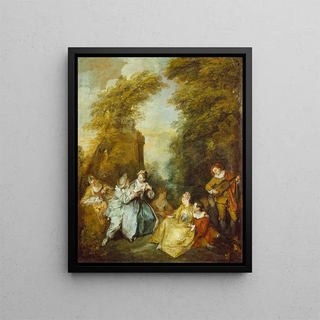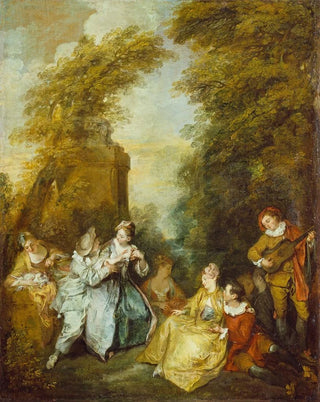Art print | A flirtatious conversation Conversation galante - Nicolas Lancret


View from behind

Frame (optional)
The art print "Une conversation galante" by Nicolas Lancret invites you to immerse yourself in the intimate and refined world of the 18th century. This piece, emblematic of the rococo style, depicts a court scene where elegance and lightness of manners converge. The characters, dressed in sumptuous costumes, appear engaged in a delicate exchange, where every gesture and glance tell a story. The soft lighting bathing the scene enhances the atmosphere of complicity and seduction, transporting the viewer to a suspended moment in time. This work, both simple and complex, stands as a true masterpiece of French painting, continuing to inspire and delight.
Style and uniqueness of the work
Lancret's style is distinguished by his ability to capture the nuances of social life of his era. The art print "Une conversation galante" features delicate pastel colors and fluid forms that evoke grace and lightness. The meticulous details of the costumes, accessories, and decor reflect a keen attention to aesthetics and visual harmony. The carefully orchestrated composition creates a balance between the characters and their environment, while revealing a palpable intimacy. The expressions of the protagonists, both playful and mysterious, add emotional depth to the work, unveiling the subtleties of human relationships. This capacity to marry aesthetics and storytelling makes Lancret an undisputed master of the genre, whose influence endures through the centuries.
The artist and his influence
Nicolas Lancret, born in 1690, is often regarded as one of the major representatives of 18th-century French painting. A student of Claude Gillot, he developed a style that moves away from academic conventions to embrace a freer, more expressive vision of daily life. Lancret is distinguished by his depiction of genre scenes, where he immortalizes the pleasures of aristocratic life with a lightness and vivacity unique to him. His work not only influenced his contemporaries but also paved the way for later artists, such as François Boucher and Jean-H

Matte finish

View from behind

Frame (optional)
The art print "Une conversation galante" by Nicolas Lancret invites you to immerse yourself in the intimate and refined world of the 18th century. This piece, emblematic of the rococo style, depicts a court scene where elegance and lightness of manners converge. The characters, dressed in sumptuous costumes, appear engaged in a delicate exchange, where every gesture and glance tell a story. The soft lighting bathing the scene enhances the atmosphere of complicity and seduction, transporting the viewer to a suspended moment in time. This work, both simple and complex, stands as a true masterpiece of French painting, continuing to inspire and delight.
Style and uniqueness of the work
Lancret's style is distinguished by his ability to capture the nuances of social life of his era. The art print "Une conversation galante" features delicate pastel colors and fluid forms that evoke grace and lightness. The meticulous details of the costumes, accessories, and decor reflect a keen attention to aesthetics and visual harmony. The carefully orchestrated composition creates a balance between the characters and their environment, while revealing a palpable intimacy. The expressions of the protagonists, both playful and mysterious, add emotional depth to the work, unveiling the subtleties of human relationships. This capacity to marry aesthetics and storytelling makes Lancret an undisputed master of the genre, whose influence endures through the centuries.
The artist and his influence
Nicolas Lancret, born in 1690, is often regarded as one of the major representatives of 18th-century French painting. A student of Claude Gillot, he developed a style that moves away from academic conventions to embrace a freer, more expressive vision of daily life. Lancret is distinguished by his depiction of genre scenes, where he immortalizes the pleasures of aristocratic life with a lightness and vivacity unique to him. His work not only influenced his contemporaries but also paved the way for later artists, such as François Boucher and Jean-H






